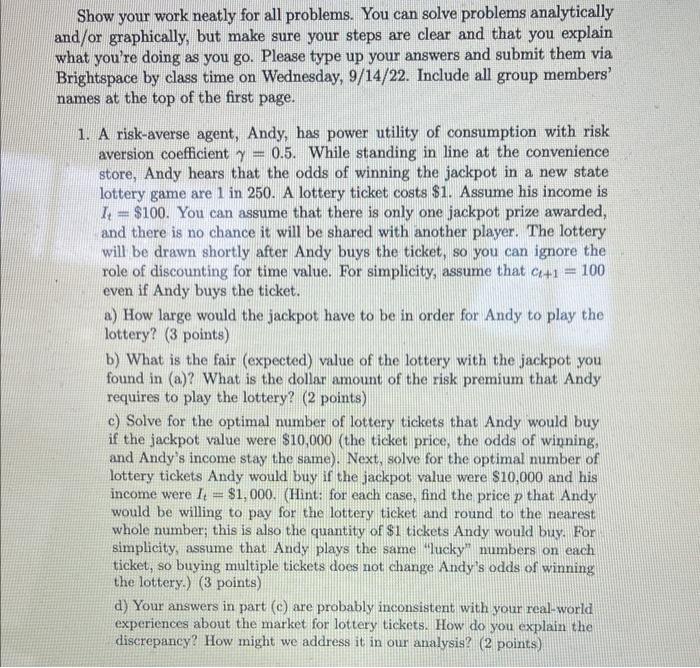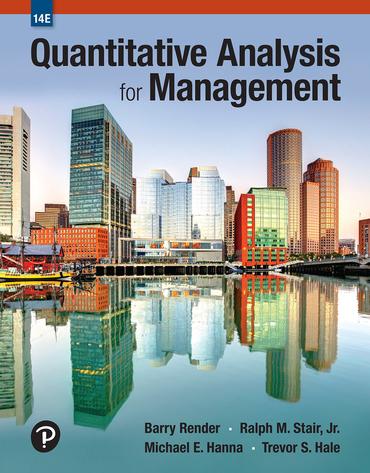Show your work neatly for all problems. You can solve problems analytically and/or graphically, but make sure your steps are clear and that you explain what you're doing as you go. Please type up your answers and submit them via Brightspace by class time on Wednesday, 9/14/22. Include all group members' names at the top of the first page. 1. A risk-averse agent, Andy, has power utility of consumption with risk aversion coefficient =0.5. While standing in line at the convenience store, Andy hears that the odds of winning the jackpot in a new state lottery game are 1 in 250 . A lottery ticket costs $1. Assume his income is It=$100. You can assume that there is only one jackpot prize awarded, and there is no chance it will be shared with another player. The lottery will be drawn shortly after Andy buys the ticket, so you can ignore the role of discounting for time value. For simplicity, assume that ct+1=100 even if Andy buys the ticket. a) How large would the jackpot have to be in order for Andy to play the lottery? (3 points) b) What is the fair (expected) value of the lottery with the jackpot you found in (a)? What is the dollar amount of the risk premium that Andy requires to play the lottery? (2 points) c) Solve for the optimal number of lottery tickets that Andy would buy if the jackpot value were $10,000 (the ticket price, the odds of winning, and Andy's income stay the same). Next, solve for the optimal number of lottery tickets Andy would buy if the jackpot value were $10,000 and his income were It=$1,000. (Hint: for each case, find the price p that Andy would be willing to pay for the lottery ticket and round to the nearest. whole number; this is also the quantity of \$1 tickets Andy would buy. For simplicity, assume that Andy plays the same "lucky" numbers on each ticket, so buying multiple tickets does not change Andy's odds of winning the lottery.) (3 points) d) Your answers in part (c) are probably inconsistent with your real-world. experiences about the market for lottery tickets. How do you explain the discrepancy? How might we address it in our analysis? ( 2 points) Show your work neatly for all problems. You can solve problems analytically and/or graphically, but make sure your steps are clear and that you explain what you're doing as you go. Please type up your answers and submit them via Brightspace by class time on Wednesday, 9/14/22. Include all group members' names at the top of the first page. 1. A risk-averse agent, Andy, has power utility of consumption with risk aversion coefficient =0.5. While standing in line at the convenience store, Andy hears that the odds of winning the jackpot in a new state lottery game are 1 in 250 . A lottery ticket costs $1. Assume his income is It=$100. You can assume that there is only one jackpot prize awarded, and there is no chance it will be shared with another player. The lottery will be drawn shortly after Andy buys the ticket, so you can ignore the role of discounting for time value. For simplicity, assume that ct+1=100 even if Andy buys the ticket. a) How large would the jackpot have to be in order for Andy to play the lottery? (3 points) b) What is the fair (expected) value of the lottery with the jackpot you found in (a)? What is the dollar amount of the risk premium that Andy requires to play the lottery? (2 points) c) Solve for the optimal number of lottery tickets that Andy would buy if the jackpot value were $10,000 (the ticket price, the odds of winning, and Andy's income stay the same). Next, solve for the optimal number of lottery tickets Andy would buy if the jackpot value were $10,000 and his income were It=$1,000. (Hint: for each case, find the price p that Andy would be willing to pay for the lottery ticket and round to the nearest. whole number; this is also the quantity of \$1 tickets Andy would buy. For simplicity, assume that Andy plays the same "lucky" numbers on each ticket, so buying multiple tickets does not change Andy's odds of winning the lottery.) (3 points) d) Your answers in part (c) are probably inconsistent with your real-world. experiences about the market for lottery tickets. How do you explain the discrepancy? How might we address it in our analysis? ( 2 points)







